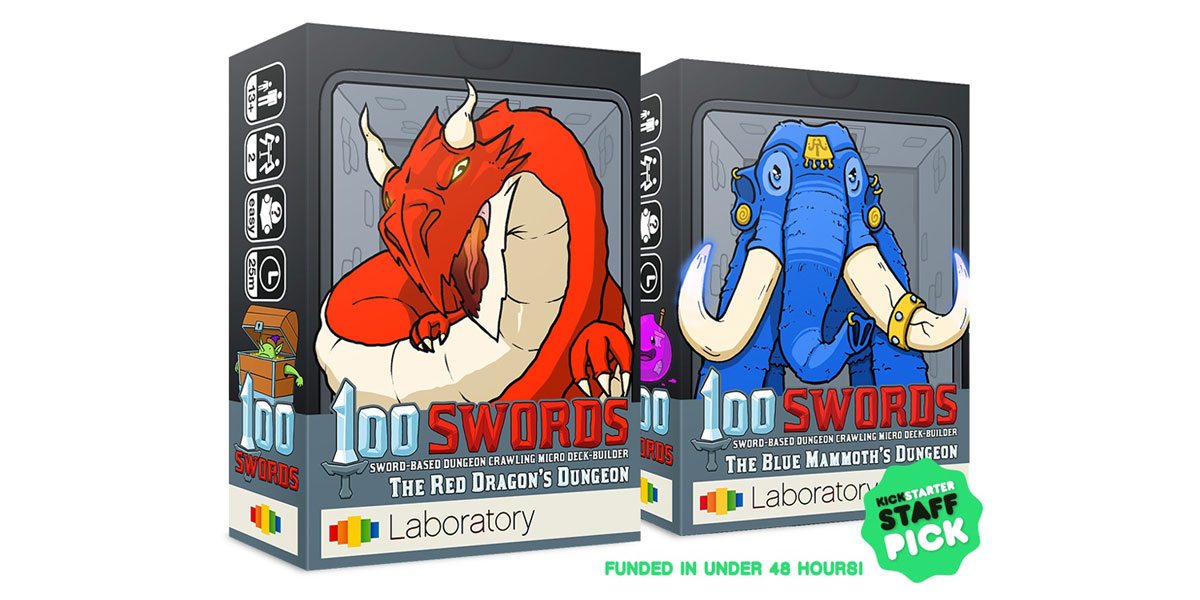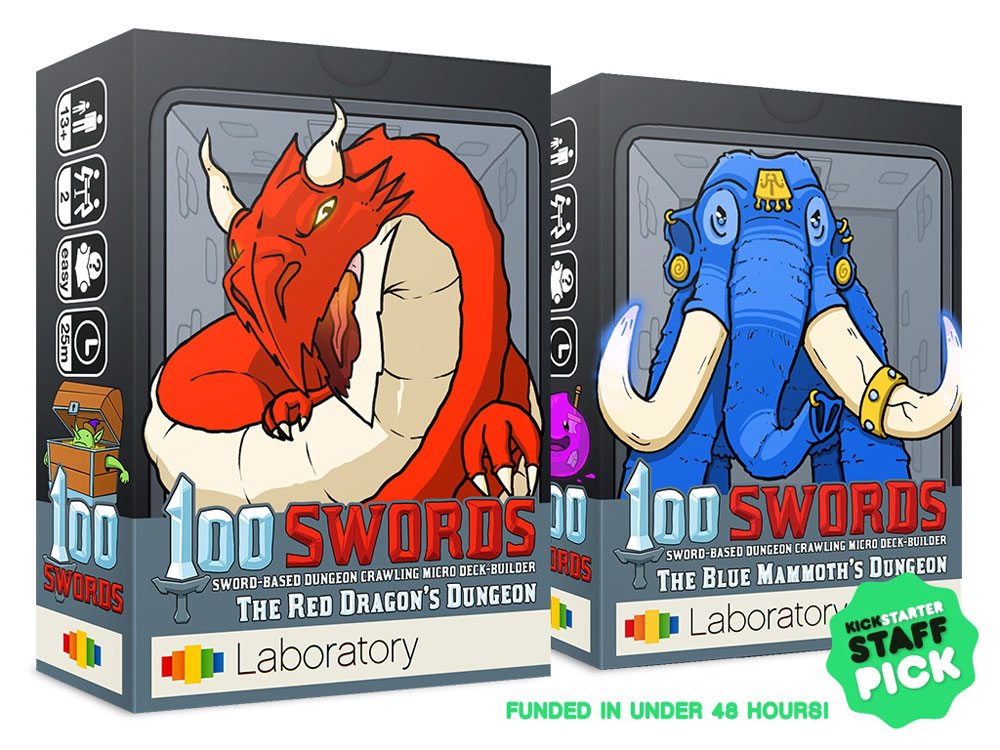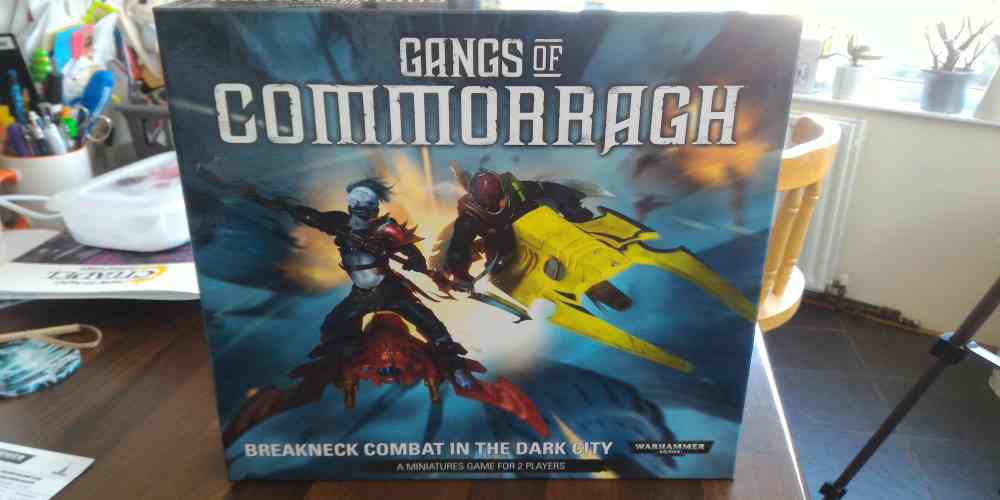Armed with nothing but some boots, an awkward sword, and several crappy swords, you set off into the dungeon in hopes of slaying monsters, finding better equipment, and–just maybe–defeating the dungeon boss. Grab a friend (or an enemy) for a quick two-player session of 100 Swords.
At a glance: 100 Swords is a micro-deck-building game for 2 players, ages 13 and up, and takes about 25 minutes to play. It’s currently on Kickstarter, with a $14 base pledge for a copy of the game. There are actually two different decks available, so you can get either one, or get both for $27. I think the game is simple enough to learn that you can play with younger kids, too–I taught my 8-year-old to play without too much trouble, and the only mildly inappropriate thing is the “Crappy Sword” card.
New to Kickstarter? Read our crowdfunding primer.
Components:
54 Cards:
- 18 Starting Cards (12 Crappy Swords, 2 Awkward Swords, 4 Boots)
- 3 Rental Cards (1 Key, 1 Sleepy Potion, 1 Adventure-Scope)
- 16 Dungeon Items
- 13 Monsters (12 Standard Monsters, 1 Boss)
- 3 Doors
- 1 Movement Tracker
The game is a deck of cards in a tuckbox. The cards are pretty easy to understand: at the top left are some icons showing how much movement or strength a card is worth. The top right has a gold value (score). Then there’s an image, a name, and a possible effect of the card. Finally, at the bottom is a cost, either in energy (fist) or strength (lightning bolt).
The illustrations are cartoony, and some of them are cute and some are silly. Nothing is too scary, though the boss at least is more serious-looking.
The one thing I thought was odd about the components is that each player has 9 starting cards. With a hand size of 5 cards, that means you have to shuffle after your first turn, which is weird in a deck-building game. The designers at Laboratory Games explained that with only a 54-card deck, they didn’t want to have too many cards be starting items because that mean fewer things in the dungeon deck, plus it also meant that your deck would have more of the weaker starting items. I get that, but it still feels funny having to shuffle so soon.
The movement tracker basically shows where you are in the 5-card dungeon, and is a card with an image of a boot on it. In the prototype, it had the same back as the rest of the cards, so it could easily get shuffled into the deck if you’re not paying attention.
How to Play
You can read a draft of the rules here.
The goal of the game is to get the most gold value in cards by the end of the game.
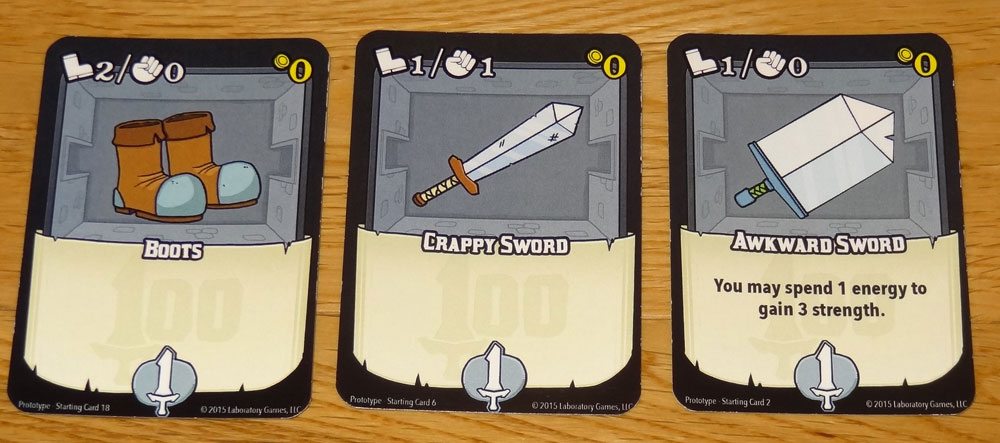
Each player starts with their own deck of 9 starting cards: 1 Awkward Sword, 2 Boots, and 6 Crappy Swords. These form their starting decks–they’re shuffled, and each player draws a hand of 5.

The three Rental item cards are set face-up on the table. The rest of the cards will form the dungeon deck. Shuffle all but the Boss together. Then draw 9 cards, shuffle them with the Boss, and place all of them at the bottom of the deck. Finally, draw the top 5 cards from the deck and place them face-down in a row, forming the dungeon. The movement tracker is set to one side.
On your turn, you play cards to explore the dungeon, fight monsters, and gain equipment. Each card may be played for three things: as movement, strength, or energy. Movement and strength are shown at the top of the card as a boot and a fist. For energy, you play the card sideways and it is worth 1 energy (unless otherwise noted on the card). Before you enter the dungeon, you may spend cards as energy to rent any of the rental items, which you’ll get to use during your turn–rental items are always returned to the table after your turn ends.
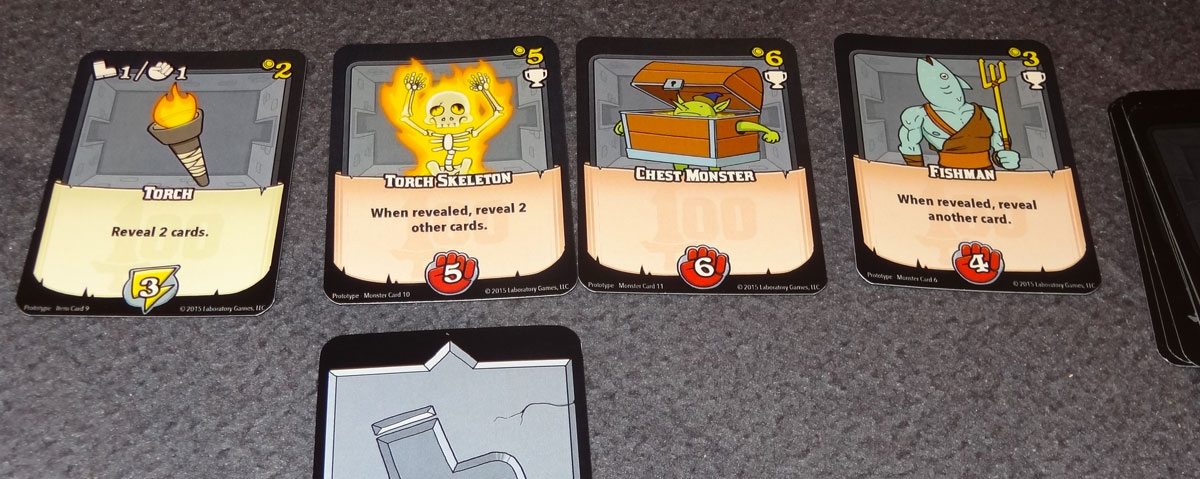
When you play movement, you get to move the movement tracker forward into the dungeon. When you stop moving, you get to peek at the card–monsters must be revealed, but items do not have to be revealed. You may keep moving past monsters that you just revealed on your turn, but you may not move past already revealed monsters without fighting them.
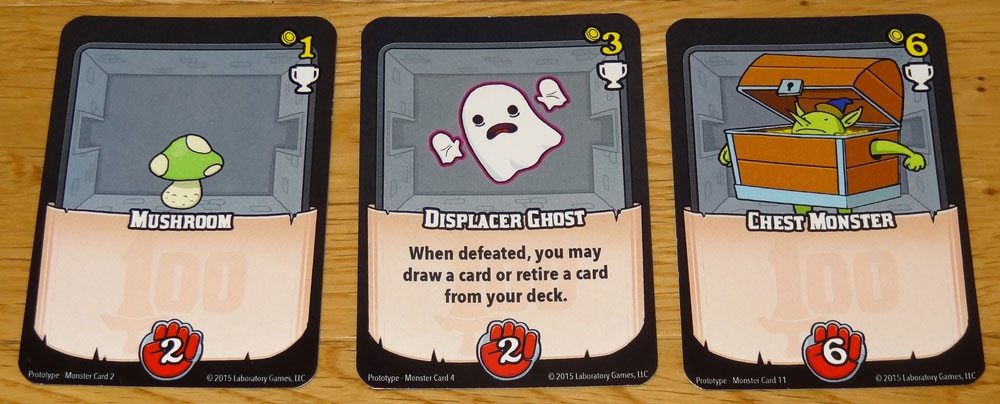
To fight a monster, play cards from your hand for strength until you have enough to pay the cost of the monster (shown in the red fist at the bottom). Defeat it, and it goes into your score pile (face-up next to your deck.)

To buy equipment, play cards as energy until you can pay the cost (shown as a lightning bolt), and then take the new equipment into your hand, where it may be played during your turn.
At the end of your turn, discard all the cards you’ve played, plus any left in your hand, and draw a new hand of 5 cards from your deck, shuffling as necessary. You’ll also slide all the cards toward the entrance of the dungeon to fill in any spaces, and then refill the dungeon from the dungeon deck.

If somebody defeats the Boss, or there aren’t enough cards to refill the deck, the game ends. Players gather up all their cards (deck, discard, score pile, hand) and count up all the gold coins. Highest score wins–ties go to the player with more swords, then the player who slayed more monsters.
A couple other notes: there are some cards (both monsters and equipment) that will let you “retire” cards, pulling them out of your deck or discard and putting them into your score pile. It’s a way of weeding the weaker stuff from your deck.
Also: there are are three Door cards in the dungeon, which must be opened with the rental Key to pass if they’ve been revealed. If you don’t have a key, well, then you’ll have to wait until next time.

The Verdict
Spoiler: despite the title, there aren’t actually 100 swords in this game. There are a lot of them, but there are only 54 cards in the whole deck, so don’t get your hopes up.
I’ve played a prototype copy of 100 Swords several times now, and it’s a fun little deck-building game. For people who haven’t ever played a deck-building game before, this is a nice, short game that teaches the gist of it in a way that’s easy to learn. But for those familiar with deck-building, it also offers some interesting twists on the genre.
Most deck-building games have a marketplace of some sort–that is, some number of cards available to be acquired into your deck. Dominion has several stacks of cards that are always available. Ascension has a random selection of cards that gets replaced from a central deck. 100 Swords is more like Ascension, with 5 cards, but the twist is that they’re face-down, and you have to spend resources just to see what they are (by moving), and then more resources to acquire them (either strength or energy, depending on the card). It makes the game somewhat puzzle-like, as you decide each turn before you begin: which cards will you use for movement? Which will you save for strength or energy? How far can you afford to travel into the dungeon?
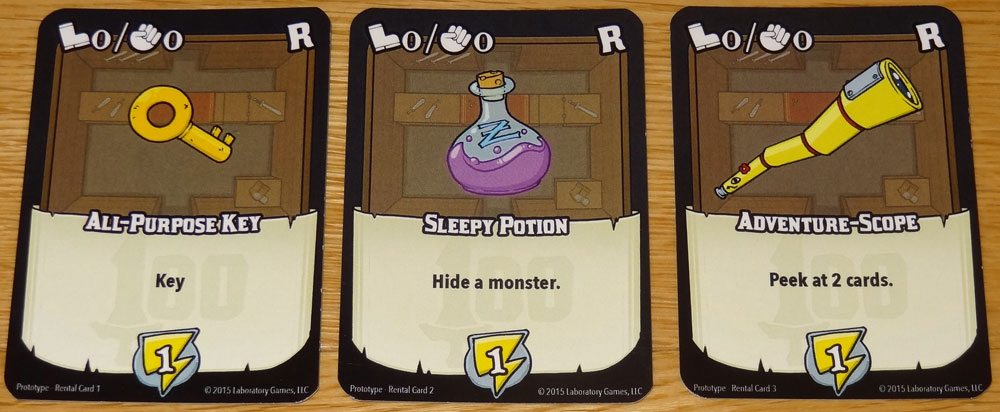
I like the rental items, too, though in the games I’ve played we rarely use the Adventure-Scope, which lets you peek at two cards. The most popular item is the Key, generally when somebody has found either a door or the Treasure Chest. The Sleepy Potion lets you hide a monster card, so that’s handy if there’s a face-up monster you want to bypass for a shot at something better.
There’s a good variety in the monsters and the swords, though there are only so many things that let you weed through your deck. In some of the games I’ve played, one player was able to get almost all of the cards with retire abilities, which meant that they were able to make their deck much more efficient by getting rid of Crappy Swords and having access to better weapons. I suppose that’s the nature of a two-player game, that there can be some luck of the draw just in what you happen to encounter.
You do have some choice in the matter, though–for many of your cards you choose whether to use them for movement or strength, so you can decide how far to move if there aren’t any revealed monsters. I suppose that’s where the Adventure-Scope would be handy–peek ahead at a couple of cards, and then see if they’re worth moving to.
I’ve only played the Red Dragon’s Dungeon, so I don’t know much about the Blue Mammoth’s Dungeon, except that it has a different set of cards that can be mixed and matched as you please. Although the rules don’t explicitly say so, I think it would probably be possible to shuffle two decks together and play with four players–balancing the game may be a little iffier in that case, though.
Overall, I think 100 Swords is another fine pocket game from Laboratory Games. I’ve enjoyed a couple of their previous releases, and I like that they’ve got a focus (so far, at least) on small games from big genres: Shift took a CCG and boiled it down to one card per player, and Province is a pocket-sized worker placement game for 2 players. They’re a fun way to introduce different game mechanics to new gamers without overwhelming them, and 100 Swords may be one that I’ll throw into my travel bag for a quick gaming fix when I need it.
For more information or to make your pledge, visit the 100 Swords Kickstarter page.
Disclosure: I received a prototype copy of the Red Dragon’s Dungeon deck for review.
